INSTITUT SUPERIEUR D'ANTHROPOLOGIE
INSTITUTE OF ANTHROPOLOGY
ONLINE COURSES / COURS A DISTANCE
DEBUT COURS : SEPTEMBRE 2023
REGISTER NOW
ANGLETERRE – 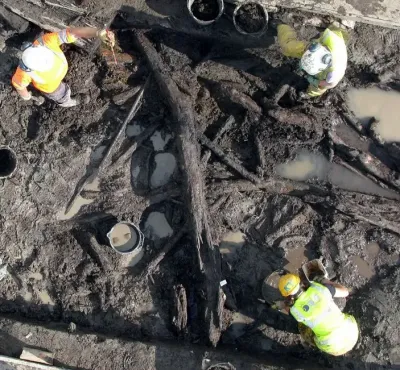 Carlisle - The recent discovery of more than 600 red ochre fragments at a 6,500-year-old ceremonial site near Carlisle, northwestern England, supports an ancient Greek explorer’s account from the 4th century BC in which Britons are referred to as “the painted people.” Pytheas of Massalia, an explorer from the Greek colony that is modern-day Marseille, in southern France, was quoted by later geographers to have spoken of Great Britain as Prettanike, a term derived from the Celtic word Pretani, meaning “the [land of the] painted ones” or “the tattooed folk.”The Carlisle red ochre discovery -the largest find of red ochre pieces yet found in the UK- not only complements the linguistic evidence on ancient Britons’ tradition of body painting, but also suggests a longheld gathering or festival which featured body painting rituals, according to The Indepenent. A number of stones that would have been used to grind ochre deposits into powder were also found, along hundreds of thousands of fragments of flint. Additional findings support the idea that the people that gathered at the Stone Age site in Carlisle, most probably during the salmon-fishing season in spring, originated from across Britain. Pytheas of Massalia was the first-ever Mediterranean to reach and explore Great Britain and the Arctic Circle. According to Henry Fanshawe Tozer, Pytheas’ voyage to the north took place at about 330 BC, derived from three main sources. Sadly, his original writings, titled On The Ocean, did not survive, but he is quoted in the works of later geographers, such as Strabo’s Geographica, Pliny’s Natural History and Diodorus of Sicily’s Bibliotheca historica. Pytheas most likely crossed the English Channel and first reached Britain from the coast of what is modern-day Cornwall, where he described the flourishing trade of tin, before he continued north along the west coasts of what are now England, Wales and Scotland. There, he described the area’s inhabitants, a Celtic-speaking people whom he called the Pretani, which would translate as “the painted ones.” This could be the name that these very people called themselves, or the name in which their neighbours described them. Despite the thousands of years between the estimated period of use of the ritual site in Carlisle where the ochre fragments were discovered, and Pytheas’ voyage, previous finds in other parts of the U.K. suggest that red ochre continued to be used by prehistoric Britons until at least the Iron Age, which could bring the body painting habit closer in time to the so-called classical antiquity and Pytheas’ account of the people of the Prettanike.
Carlisle - The recent discovery of more than 600 red ochre fragments at a 6,500-year-old ceremonial site near Carlisle, northwestern England, supports an ancient Greek explorer’s account from the 4th century BC in which Britons are referred to as “the painted people.” Pytheas of Massalia, an explorer from the Greek colony that is modern-day Marseille, in southern France, was quoted by later geographers to have spoken of Great Britain as Prettanike, a term derived from the Celtic word Pretani, meaning “the [land of the] painted ones” or “the tattooed folk.”The Carlisle red ochre discovery -the largest find of red ochre pieces yet found in the UK- not only complements the linguistic evidence on ancient Britons’ tradition of body painting, but also suggests a longheld gathering or festival which featured body painting rituals, according to The Indepenent. A number of stones that would have been used to grind ochre deposits into powder were also found, along hundreds of thousands of fragments of flint. Additional findings support the idea that the people that gathered at the Stone Age site in Carlisle, most probably during the salmon-fishing season in spring, originated from across Britain. Pytheas of Massalia was the first-ever Mediterranean to reach and explore Great Britain and the Arctic Circle. According to Henry Fanshawe Tozer, Pytheas’ voyage to the north took place at about 330 BC, derived from three main sources. Sadly, his original writings, titled On The Ocean, did not survive, but he is quoted in the works of later geographers, such as Strabo’s Geographica, Pliny’s Natural History and Diodorus of Sicily’s Bibliotheca historica. Pytheas most likely crossed the English Channel and first reached Britain from the coast of what is modern-day Cornwall, where he described the flourishing trade of tin, before he continued north along the west coasts of what are now England, Wales and Scotland. There, he described the area’s inhabitants, a Celtic-speaking people whom he called the Pretani, which would translate as “the painted ones.” This could be the name that these very people called themselves, or the name in which their neighbours described them. Despite the thousands of years between the estimated period of use of the ritual site in Carlisle where the ochre fragments were discovered, and Pytheas’ voyage, previous finds in other parts of the U.K. suggest that red ochre continued to be used by prehistoric Britons until at least the Iron Age, which could bring the body painting habit closer in time to the so-called classical antiquity and Pytheas’ account of the people of the Prettanike.
https://greekreporter.com/2023/08/26/archaeological-find-supports-ancient-greek-explorers-account-britons/
TURQUIE – 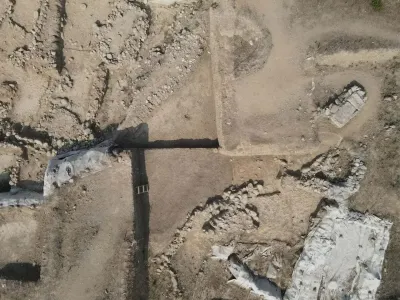
 Yeşilova Höyük - One of the earliest water channels in history dating back 8,200 years was found during the excavation work carried out in the Yeşilova Höyük (Yeşilova mound). Yeşilova Höyük is a mound in the Bornova district of İzmir, Turkey, and is the oldest known prehistoric human settlement in the area of İzmir. The mound that is being excavated has already uncovered significant Neolithic Age traces as well as a wealth of information about the earliest settlers in the region of Izmir off the coast of the Aegean, their surroundings, and their culture. For instance, unlike Catalhoyuk in central Anatolia, where the houses are next to one another, they lived in separate houses with separate roof systems. The findings from the joint project between the Culture and Tourism Ministry of Turkey, Ege University, and the local authorities, are significant because they suggest that the historical settlements in the Izmir area go back 8,500 years, to 6500 BCE. An 8,200-year-old water channel that was discovered recently during the exploration of Yeşilova Mound represents an important archaeological achievement. Ingeniously, it was discovered that the early city dwellers had manually changed the watercourse so that it flowed right into their immediate area. Associate Professor Zafer Derin of Ege University, who located the mound and has been the excavation leader since 2005, explains that: “Here at Yeşilova Mound, the site of Izmir’s inaugural village settlement, our current focus is deciphering the nuances of their urban planning. The excavation brought to light a canal, spanning 6.5 meters (21.3 feet) in width, traversing through the heart of the settlement. With stone-lined edges and an elevated earthen embankment, this architectural marvel persisted over eight millennia—spanning four generations.” “The canal eventually silted over time, yet its legacy endured, as evidenced by Roman-era efforts to channel water through the same area using conduits. The canal’s grandeur is emphasized by its expansive width, and the settlement developed harmoniously on both flanks. By carefully accommodating potential flooding, the settlement demonstrated unparalleled foresight. Our measurements have identified the canal’s length at 220 meters, although we’ve only managed to uncover a fragment because of the dense accumulation of gravel within.” Derin highlighted the significance of the settlers’ urban planning prowess. “The pioneers of this city ingeniously harnessed water accessibility, masterfully shaping their environment. Their urban blueprint might just be a pioneering instance in Anatolian history, showcasing their exceptional adaptability,” he added.
Yeşilova Höyük - One of the earliest water channels in history dating back 8,200 years was found during the excavation work carried out in the Yeşilova Höyük (Yeşilova mound). Yeşilova Höyük is a mound in the Bornova district of İzmir, Turkey, and is the oldest known prehistoric human settlement in the area of İzmir. The mound that is being excavated has already uncovered significant Neolithic Age traces as well as a wealth of information about the earliest settlers in the region of Izmir off the coast of the Aegean, their surroundings, and their culture. For instance, unlike Catalhoyuk in central Anatolia, where the houses are next to one another, they lived in separate houses with separate roof systems. The findings from the joint project between the Culture and Tourism Ministry of Turkey, Ege University, and the local authorities, are significant because they suggest that the historical settlements in the Izmir area go back 8,500 years, to 6500 BCE. An 8,200-year-old water channel that was discovered recently during the exploration of Yeşilova Mound represents an important archaeological achievement. Ingeniously, it was discovered that the early city dwellers had manually changed the watercourse so that it flowed right into their immediate area. Associate Professor Zafer Derin of Ege University, who located the mound and has been the excavation leader since 2005, explains that: “Here at Yeşilova Mound, the site of Izmir’s inaugural village settlement, our current focus is deciphering the nuances of their urban planning. The excavation brought to light a canal, spanning 6.5 meters (21.3 feet) in width, traversing through the heart of the settlement. With stone-lined edges and an elevated earthen embankment, this architectural marvel persisted over eight millennia—spanning four generations.” “The canal eventually silted over time, yet its legacy endured, as evidenced by Roman-era efforts to channel water through the same area using conduits. The canal’s grandeur is emphasized by its expansive width, and the settlement developed harmoniously on both flanks. By carefully accommodating potential flooding, the settlement demonstrated unparalleled foresight. Our measurements have identified the canal’s length at 220 meters, although we’ve only managed to uncover a fragment because of the dense accumulation of gravel within.” Derin highlighted the significance of the settlers’ urban planning prowess. “The pioneers of this city ingeniously harnessed water accessibility, masterfully shaping their environment. Their urban blueprint might just be a pioneering instance in Anatolian history, showcasing their exceptional adaptability,” he added.
https://arkeonews.net/one-of-the-earliest-water-channels-in-history-dating-back-8200-years-was-discovered-in-western-turkiye/
CHINE – 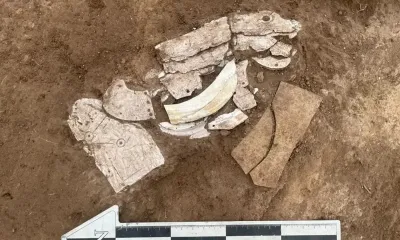 Chifeng - Archaeologists discovered a dragon made of mussel shells earlier this week in Chifeng, North China’s Inner Mongolia Autonomous Region, which dates back much further than the iconic C-shaped dragon made of jade, which is also from the Neolithic Hongshan Culture. The city of Chifeng is located in the sprawling plains of North China’s Inner Mongolia Autonomous Region. Its historical significance has been enhanced this week by a monumental discovery that has the potential to rewrite aspects of ancient Chinese cultural narratives. Investigating this new discovery and its implications reveals a complex and captivating story of the ancient Hongshan Culture. Historical records place the Hongshan Culture between 4700 to 2900 BC. Among its myriad contributions to ancient Chinese civilization, it is perhaps best known for its exquisite jade carvings. In a moment that can only be described as serendipitous, archaeologists stumbled upon a puzzling artifact: a dragon meticulously assembled from mussel shells. The discovery is a significant find that fills a gap in archaeologists’ knowledge of the dragon symbol within the early Hongshan Culture, said Song Jinshan, president of Inner Mongolia Institute of Cultural Relics and Archaeology. The puzzle-like dragon is pieced together from several mussel shells that form its head, body, and tail, according to Hu Chunbo, the head of the excavation project at the Caitaopo Site in the Songshan district in Chifeng. This intriguing dragon, measuring about 20 centimeters long, is a mosaic of nature’s puzzles. The entire structure — from the head to the tail — reflects a keen understanding of anatomy and a commendable appreciation of art. The unearthed items, which were found alongside the fragments of two pottery wares, are typical of the Hongshan Culture.
Chifeng - Archaeologists discovered a dragon made of mussel shells earlier this week in Chifeng, North China’s Inner Mongolia Autonomous Region, which dates back much further than the iconic C-shaped dragon made of jade, which is also from the Neolithic Hongshan Culture. The city of Chifeng is located in the sprawling plains of North China’s Inner Mongolia Autonomous Region. Its historical significance has been enhanced this week by a monumental discovery that has the potential to rewrite aspects of ancient Chinese cultural narratives. Investigating this new discovery and its implications reveals a complex and captivating story of the ancient Hongshan Culture. Historical records place the Hongshan Culture between 4700 to 2900 BC. Among its myriad contributions to ancient Chinese civilization, it is perhaps best known for its exquisite jade carvings. In a moment that can only be described as serendipitous, archaeologists stumbled upon a puzzling artifact: a dragon meticulously assembled from mussel shells. The discovery is a significant find that fills a gap in archaeologists’ knowledge of the dragon symbol within the early Hongshan Culture, said Song Jinshan, president of Inner Mongolia Institute of Cultural Relics and Archaeology. The puzzle-like dragon is pieced together from several mussel shells that form its head, body, and tail, according to Hu Chunbo, the head of the excavation project at the Caitaopo Site in the Songshan district in Chifeng. This intriguing dragon, measuring about 20 centimeters long, is a mosaic of nature’s puzzles. The entire structure — from the head to the tail — reflects a keen understanding of anatomy and a commendable appreciation of art. The unearthed items, which were found alongside the fragments of two pottery wares, are typical of the Hongshan Culture.
https://arkeonews.net/archaeologists-discovered-a-dragon-made-of-mussel-shells-in-in-inner-mongolia/
MEXIQUE – 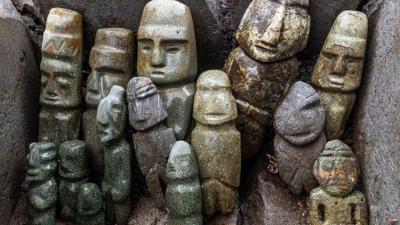 Tenochtitlan - Archaeologists have discovered a significant offering of 15 green stone sculptures at the former Great Temple of the Aztecs in Mexico City. Earrings, stone beads, shells, snails, coral and sea sand were also found in a stone container, the National Institute of Anthropology and History (INAH) said on Friday (local time). The manager of the excavation project, Leonardo López Luján, spoke of an archaeological "super find". The so-called Offering 186, which lay under the platform on the back facade of the Templo Mayor, dates from the time of the ruler Moctezuma I (1440-1469). The sculptures are probably much older, the INAH said. The team led by archaeologist López Luján found a total of 14 male sculptures measuring up to 30 centimeters and one female figure measuring three centimeters. More than 1900 sea objects and 137 green stone beads were also found.
Tenochtitlan - Archaeologists have discovered a significant offering of 15 green stone sculptures at the former Great Temple of the Aztecs in Mexico City. Earrings, stone beads, shells, snails, coral and sea sand were also found in a stone container, the National Institute of Anthropology and History (INAH) said on Friday (local time). The manager of the excavation project, Leonardo López Luján, spoke of an archaeological "super find". The so-called Offering 186, which lay under the platform on the back facade of the Templo Mayor, dates from the time of the ruler Moctezuma I (1440-1469). The sculptures are probably much older, the INAH said. The team led by archaeologist López Luján found a total of 14 male sculptures measuring up to 30 centimeters and one female figure measuring three centimeters. More than 1900 sea objects and 137 green stone beads were also found.
https://www.indonewyork.com/breaking/archeology-superfund-significant-aztec-offering-discovered-h94261.html
KAZAKHSTAN - 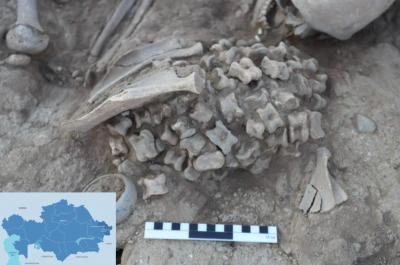 - Ainabulak-Temirsu - Led by Rinat Zhumatayev, Head of the Department of Archaeology, Ethnology, and Muzology of KazNU, in collaboration with specialists from the University of Cambridge, these excavations have steadily unveiled secrets of the past. The ongoing excavations have gained momentum since 2016 when the journey to explore the region’s historical treasures commenced in the Zaisan district, spearheaded by Abdesh Toleubaev. “The results of our work were showcased at the first international exhibition, specifically in Moscow, London, and Kazan. Thanks to the exhibition ‘Altai – the Cradle of the Turkic World,’ we have strengthened our relationship with Cambridge University. Since 2020, archaeological excavations have been conducted in collaboration with scientist Rebecca Roberts,” said Rinat Zhumatayev. The artifacts, belonging to the Bronze Age spanning from the 25th to 18th centuries BC, were initially discovered in the ancient burial grounds of Ainabulak in 2017. Exploration continued in subsequent years in Yelek, and in 2023, focus returned to Zaisan. The unearthed artifacts are set to be displayed in the historical and local history museum of the East Kazakhstan region. Local budget allocations have facilitated the preservation of these invaluable pieces. This year, the team’s efforts have yielded additional discoveries. The Ainabulak-Temirsu burial ground has been meticulously mapped, and multiple mounds have been explored. Notably, one mound contained the remains of a woman. Beside her, an array of intriguing artifacts was uncovered, including silver dishes, 180 alcoves, and a distinctive silver item featuring a frog motif. While the precise era of these discoveries remains to be determined through advanced scientific analysis, the frog-adorned artifact carries immense significance. Scholars associate the frog motif with water-related rituals found in both China and Egypt, adding an intriguing layer to the ongoing research.
- Ainabulak-Temirsu - Led by Rinat Zhumatayev, Head of the Department of Archaeology, Ethnology, and Muzology of KazNU, in collaboration with specialists from the University of Cambridge, these excavations have steadily unveiled secrets of the past. The ongoing excavations have gained momentum since 2016 when the journey to explore the region’s historical treasures commenced in the Zaisan district, spearheaded by Abdesh Toleubaev. “The results of our work were showcased at the first international exhibition, specifically in Moscow, London, and Kazan. Thanks to the exhibition ‘Altai – the Cradle of the Turkic World,’ we have strengthened our relationship with Cambridge University. Since 2020, archaeological excavations have been conducted in collaboration with scientist Rebecca Roberts,” said Rinat Zhumatayev. The artifacts, belonging to the Bronze Age spanning from the 25th to 18th centuries BC, were initially discovered in the ancient burial grounds of Ainabulak in 2017. Exploration continued in subsequent years in Yelek, and in 2023, focus returned to Zaisan. The unearthed artifacts are set to be displayed in the historical and local history museum of the East Kazakhstan region. Local budget allocations have facilitated the preservation of these invaluable pieces. This year, the team’s efforts have yielded additional discoveries. The Ainabulak-Temirsu burial ground has been meticulously mapped, and multiple mounds have been explored. Notably, one mound contained the remains of a woman. Beside her, an array of intriguing artifacts was uncovered, including silver dishes, 180 alcoves, and a distinctive silver item featuring a frog motif. While the precise era of these discoveries remains to be determined through advanced scientific analysis, the frog-adorned artifact carries immense significance. Scholars associate the frog motif with water-related rituals found in both China and Egypt, adding an intriguing layer to the ongoing research.
https://astanatimes.com/2023/08/recent-discoveries-in-east-kazakhstan-unveil-mysteries-of-past/
SUISSE –  Cham-Oberwil - Archaeologists from the Office for Monument Preservation and Archaeology have made a significant discovery. They found a substantial Roman complex while digging in a gravel quarry near Cham-Oberwil, situated in the Canton of Zug, Switzerland. Positioned on a raised spot in the Äbnetwald area, the site holds traces of old villages and burial grounds from the time when people used bronze and iron. The Office for Monument Preservation and Archaeology has been doing emergency excavations at the dig site since the 1990s. In a recent study, experts uncovered a bunch of big Roman structures and rooms. These are part of a bigger setup that covers at least five hundred square meters. New archaeological findings suggest that the complex is about two thousand years old. This is revealing fresh information to researchers about a significant period when the Romans occupied the pre-Alpine area in Central Switzerland. This insight is particularly noteworthy because it is the first time in nearly a century that such detailed information about this occupation has come to light. According to Christa Ebnöther, who is a Professor of Archaeology at the University of Bern, there are only a handful of large buildings like these known from Roman times in the pre-Alpine region, unlike in other areas. She added that “what is also astounding is the relatively good preservation of the remains.” Although the exact purpose and size of the complex remain uncertain, archaeologists are still working to figure it out. They think it could have been a big fancy house, kind of like a villa, or maybe even a special building like a temple. Apart from discovering the foundational walls of the Roman complex, the team has also come across ordinary items as well as valuable objects that hint at a higher status. These include Roman tableware that was brought from Italy and Gaul, a piece of gold, coins, glass containers, parts of amphorae, and a significant collection of iron nails which were likely used in constructing wooden structures.
Cham-Oberwil - Archaeologists from the Office for Monument Preservation and Archaeology have made a significant discovery. They found a substantial Roman complex while digging in a gravel quarry near Cham-Oberwil, situated in the Canton of Zug, Switzerland. Positioned on a raised spot in the Äbnetwald area, the site holds traces of old villages and burial grounds from the time when people used bronze and iron. The Office for Monument Preservation and Archaeology has been doing emergency excavations at the dig site since the 1990s. In a recent study, experts uncovered a bunch of big Roman structures and rooms. These are part of a bigger setup that covers at least five hundred square meters. New archaeological findings suggest that the complex is about two thousand years old. This is revealing fresh information to researchers about a significant period when the Romans occupied the pre-Alpine area in Central Switzerland. This insight is particularly noteworthy because it is the first time in nearly a century that such detailed information about this occupation has come to light. According to Christa Ebnöther, who is a Professor of Archaeology at the University of Bern, there are only a handful of large buildings like these known from Roman times in the pre-Alpine region, unlike in other areas. She added that “what is also astounding is the relatively good preservation of the remains.” Although the exact purpose and size of the complex remain uncertain, archaeologists are still working to figure it out. They think it could have been a big fancy house, kind of like a villa, or maybe even a special building like a temple. Apart from discovering the foundational walls of the Roman complex, the team has also come across ordinary items as well as valuable objects that hint at a higher status. These include Roman tableware that was brought from Italy and Gaul, a piece of gold, coins, glass containers, parts of amphorae, and a significant collection of iron nails which were likely used in constructing wooden structures.
https://greekreporter.com/2023/08/27/ancient-roman-complex-switzerland/
PORTUGAL –  São Brás de Alportel - A 5,500-year-old (that is around 3500 BC) menhir has been discovered in the town of São Brás de Alportel in the District of Faro, Algarve region, in Portugal. A menhir is a single upright prehistoric stone monument, similar to a stele, and often buffed to create a phallic shape. They are one of the first stone monuments in human history, and in Europe, they are the first to have a religious function. In practice, they symbolized fertility, whether of animals, people or land, hence their form. Archaeologist António Faustino de Carvalho made the announcement in front of the now-named menhir of Monte do Trigo, which was the focus of excavations he oversaw for a week in August. This is the first archaeological excavation in the history of the municipality of So Brás de Alportel. Next to the stone monument, he explained that it is a menhir of particular importance for the Eastern Algarve and of interest on a regional scale. “Its shape, the raw material it is made of (limestone), and its dimensions are the same as the dozens of menhirs from the Neolithic period that we already know of in Barlavento, in Aljezur, Lagoa, Lagos, and Vila do Bispo. Outside these municipalities, we aren’t aware of any”.But that is not the only particularity of the archaeological find: it is also the first menhir in limestone and with characteristics that attribute it to the Neolithic period (5500 years ago, that is around 3500 BC) to be discovered in the Sotavento Algarvio.
São Brás de Alportel - A 5,500-year-old (that is around 3500 BC) menhir has been discovered in the town of São Brás de Alportel in the District of Faro, Algarve region, in Portugal. A menhir is a single upright prehistoric stone monument, similar to a stele, and often buffed to create a phallic shape. They are one of the first stone monuments in human history, and in Europe, they are the first to have a religious function. In practice, they symbolized fertility, whether of animals, people or land, hence their form. Archaeologist António Faustino de Carvalho made the announcement in front of the now-named menhir of Monte do Trigo, which was the focus of excavations he oversaw for a week in August. This is the first archaeological excavation in the history of the municipality of So Brás de Alportel. Next to the stone monument, he explained that it is a menhir of particular importance for the Eastern Algarve and of interest on a regional scale. “Its shape, the raw material it is made of (limestone), and its dimensions are the same as the dozens of menhirs from the Neolithic period that we already know of in Barlavento, in Aljezur, Lagoa, Lagos, and Vila do Bispo. Outside these municipalities, we aren’t aware of any”.But that is not the only particularity of the archaeological find: it is also the first menhir in limestone and with characteristics that attribute it to the Neolithic period (5500 years ago, that is around 3500 BC) to be discovered in the Sotavento Algarvio.
https://arkeonews.net/5500-year-old-menhir-discovered-in-portugal/
PEROU – 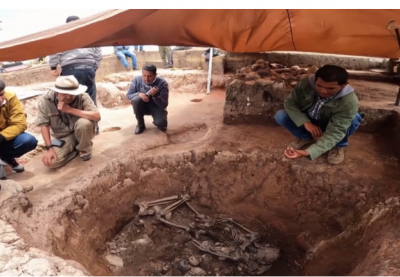 Pacopampa - Archeologists in northern Peru have unearthed a 3,000-year-old tomb which they believe might have honored an elite religious leader in the Andean country some three millennia ago. Dubbed the "Priest of Pacopampa," referring to the highland archeological zone where the tomb was found, the priest was buried under six layers of ash mixed with black earth, with decorated ceramic bowls and seals indicating ancient ritual body paint used for people of elite standing, Peru's Culture Ministry said in a statement on Saturday. Two seals were also found along the upper edges of the tomb, one with an anthropomorphic face looking east and another with a jaguar design facing west. Project leader Yuji Seki said the large size of the tomb, nearly two metres (2.2 yards) in diameter and one metre deep, was "very peculiar," as was the position of the body lying face down with one half of his body extended and feet crossed. The body was also found with a bone shaped into a tupu, a large pin used by Andean Amerindians to hold cloaks and ponchos, which would have been used to hold a woman's blanket, he added. "Though this person is a man, the associations are very peculiar," said Seki. "I think this was a leader in his time." The Pacopampa Archaeological Project has been working in the area since 2005, the ministry said, adding that rock layers indicate the priest, who would have been buried around 1,200 B.C., was some five centuries older than the tombs of the "Lady of Pacopampa" and the "Priests of the Serpent Jaguar of Pacopampa," discovered in 2009 and 2015 respectively.Last year's find of the "Priest of the Pututos," however, is believed to be older.
Pacopampa - Archeologists in northern Peru have unearthed a 3,000-year-old tomb which they believe might have honored an elite religious leader in the Andean country some three millennia ago. Dubbed the "Priest of Pacopampa," referring to the highland archeological zone where the tomb was found, the priest was buried under six layers of ash mixed with black earth, with decorated ceramic bowls and seals indicating ancient ritual body paint used for people of elite standing, Peru's Culture Ministry said in a statement on Saturday. Two seals were also found along the upper edges of the tomb, one with an anthropomorphic face looking east and another with a jaguar design facing west. Project leader Yuji Seki said the large size of the tomb, nearly two metres (2.2 yards) in diameter and one metre deep, was "very peculiar," as was the position of the body lying face down with one half of his body extended and feet crossed. The body was also found with a bone shaped into a tupu, a large pin used by Andean Amerindians to hold cloaks and ponchos, which would have been used to hold a woman's blanket, he added. "Though this person is a man, the associations are very peculiar," said Seki. "I think this was a leader in his time." The Pacopampa Archaeological Project has been working in the area since 2005, the ministry said, adding that rock layers indicate the priest, who would have been buried around 1,200 B.C., was some five centuries older than the tombs of the "Lady of Pacopampa" and the "Priests of the Serpent Jaguar of Pacopampa," discovered in 2009 and 2015 respectively.Last year's find of the "Priest of the Pututos," however, is believed to be older.
VIDEO = https://www.ctvnews.ca/mobile/sci-tech/archeologists-unearth-3-000-year-old-priestly-tomb-in-northern-peru-1.6536940